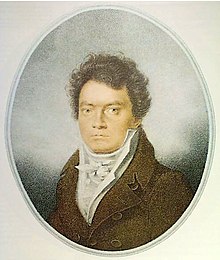8th Symphony (Beethoven)
Beethoven's Symphony No. 8 in F major, op. 93 was written in 1811 and 1812 and appeared immediately after the 7th symphony .
Emergence
Beethoven had given up on a piano concerto project that he began immediately after the Seventh Symphony; Material from this abandoned piano concerto flowed into the 8th Symphony.
Beethoven worked a. a. during his spa stay in Teplitz - there he wrote his famous, possibly never sent letter to the Immortal Beloved - working on the symphony.
Beethoven's secretary and later biographer Anton Felix Schindler claimed in his Beethoven biography from 1860 that the metronome invented by Johann Nepomuk Mälzel was the inspiration for the even beat of the second movement. Accordingly, the second movement would have arisen from a canon that Beethoven had composed for Mälzel's departure before his upcoming trip to England. However, some circumstances (for example that Mälzel's journey did not take place until 1813 and the metronome in its known form was not built until 1815) cast doubt on Schindler's portrayal. The musicologist Stanley Howell considers the canon itself to be a forgery by Schindler.
Orchestral line-up
Two flutes , two oboes , two clarinets , two bassoons , two horns , two trumpets , timpani , strings in five voices (first violin , second violin, viola , cello , double bass )
Sentence names
- 1. Allegro vivace e con brio
- 2. Allegretto scherzando
- 3. Tempo di Menuetto
- 4. Allegro vivace
| Tact | section | content |
|---|---|---|
| 1-103 | Exposure | |
| 1-12 | Topic I, Part A | |
| 13-37 | Topic I, part B | |
| 37-51 | Topic II | |
| 52-70 | Reconciliation | |
| 70-72 | Topic III, Part A | |
| 73-79 | Topic III, Part B | |
| 80-90 | Theme III, repetition | |
| 90-103 / 104 | Final group | |
| 105-197 | execution | |
| 198-289 | Recapitulation | Topic I, part A1 |
| 203 | Topic I, part A2 | |
| 234 | Topic II | |
| 267 | Topic III, Part A | |
| 271 | Topic III, Part B | |
| 290-373 | Coda |
To the music
The 8th symphony is characterized by particular cheerfulness and zest for life. Behind this cheerful superficiality, v. a. the "Allegretto scherzando" playing with the conventions of the time, peculiar musical twists and turns. An unstable sixth fourth chord , the keynote of which is enormously weakened by instrumentation, opens this movement. For this reason, too, the usual slow second movement is missing. Instead, there is an Allegretto scherzando and a Tempo di Menuetto , which are used alternatively as the third movement in the classical symphony.
The coziness suggested by the tempo “Minuet” in the third movement is exaggerated to the point of irony.
effect
The premiere took place on February 27, 1814 in an "academy" organized by Beethoven in the large Redoutensaal in Vienna .
Beethoven himself called it the “Little F major” (with regard to the other F major symphony, the sixth, Pastorale ). He evidently meant the length, but not his appreciation. At the world premiere, it was not as well received as the 7th Symphony. According to a report by Beethoven's student Carl Czerny , Beethoven annoyed his 8th symphony, "because it is much better".
The Allgemeine Musikische Zeitung wrote about the performance of the symphony, during which the 7th symphony, a trio and " Wellingtons Sieg " were heard:
“The greatest attention of the audience seemed to be directed to this latest product from B.'s muse, and everything was in the greatest anticipation; but after listening to it once, it was not accompanied by the enthusiasm that distinguishes a work that is generally liked: in short, it did not cause a sensation - as the Italians say. Ref. Is of the opinion that the cause is by no means due to a weaker or less artistic treatment; (for here, too, as in all of B.'s works of this genre, that peculiar spirit breathes through which its originality is always maintained :) but, partly in the insufficiently considered calculation of allowing this symphony to follow the one in A major, partly in the oversaturation of so much beauty and splendor that has already been enjoyed, which naturally leads to relaxation. If this symphony is given alone in the future, we in no way doubt its favorable success. "
As the musicologist Harry Goldschmidt put it, the symphony is "much misunderstood because it is understood too superficially."
literature
- Renate Ulm (Ed.): The 9 symphonies of Beethoven. Origin, interpretation, effect. Foreword by Lorin Maazel . 6th edition. Bärenreiter, Kassel et al. 2009, ISBN 978-3-7618-1241-9 , ( Bärenreiter introduction to works ).
Web links
- 8th Symphony (Beethoven) : Sheet music and audio files in the International Music Score Library Project
Individual evidence
- ↑ Renate Ulm (Ed.): The 9 symphonies of Beethoven . Bärenreiter, Kassel 1994, ISBN 3-7618-1241-8 , p. 227f.
- ↑ Renate Ulm (Ed.): The 9 symphonies of Beethoven . Bärenreiter, Kassel 1994, ISBN 3-7618-1241-8 , pp. 231-233
- ↑ Lewis Lockwood : Beethoven: His Music - His Life. Metzler, 2009, ISBN 978-3-476-02231-8 , p. 183
- ↑ Stanley Howell: The Mälzelkanon - another forgery by Schindler ? In: On Beethoven 2 - Essays and Documents. Edited by Harry Goldschmidt, Berlin 1984.
- ↑ Renate Ulm (Ed.): The 9 symphonies of Beethoven . Bärenreiter, Kassel 1994, ISBN 3-7618-1241-8 , pp. 235-237
- ^ Harry Goldschmidt : Beethoven - Introduction to Works. Leipzig 1975, p. 57
